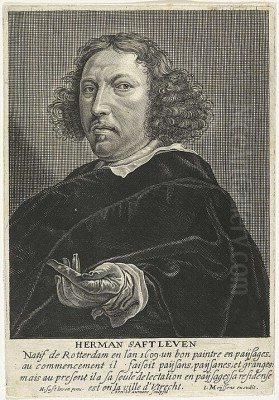
Herman Saftleven the Younger (1609-1685) stands as a significant figure in the rich tapestry of Dutch Golden Age art. A versatile artist active primarily during the Baroque period, Saftleven distinguished himself as a painter, printmaker, and draughtsman. He is particularly celebrated for his meticulously detailed landscape paintings, especially views along the Rhine and Meuse rivers, and for his scientifically precise botanical studies. Born into an artistic family in Rotterdam, he spent the majority of his prolific career in Utrecht, becoming a central figure in the city's artistic life and leaving behind a legacy that continues to be appreciated for its technical skill and keen observation of the natural world.
Early Life and Artistic Formation
Herman Saftleven was born in Rotterdam in 1609. Artistry ran deep in his family. His father, Herman Saftleven the Elder (d. 1627), was himself a painter, though less known, and likely provided initial training to his sons. Herman the Younger was one of several siblings who pursued artistic careers; his brothers Cornelis Saftleven (1607-1681) and Abraham Saftleven also became painters, while his sister Sara Saftleven practiced as a watercolorist. This familial environment undoubtedly nurtured his early artistic inclinations.
While details of his earliest training remain somewhat obscure beyond the likely influence of his father, Saftleven's formative years exposed him to the burgeoning landscape traditions of the Netherlands. Early works suggest the influence of prominent Dutch landscape painters such as Jan van Goyen and Pieter de Molijn. These artists were pioneers in developing a more naturalistic approach to landscape, focusing on tonal harmonies and atmospheric effects, elements that Saftleven would absorb and later adapt into his own unique style.
Around 1632, Herman Saftleven made a pivotal move, relocating from Rotterdam to the city of Utrecht. This city would become his home and the primary center for his artistic activities for the rest of his life, spanning over five decades until his death in 1685. Utrecht offered a vibrant artistic community and opportunities for patronage that proved crucial for his career development.
Utrecht: The Center of a Flourishing Career
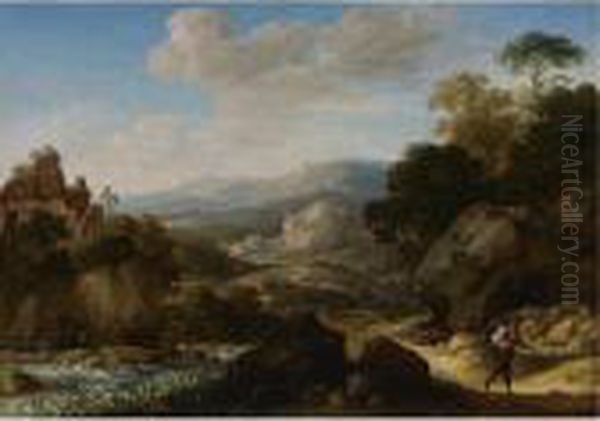
Upon settling in Utrecht, Herman Saftleven quickly integrated into the local art scene. He became a member of the Guild of Saint Luke, the professional organization for painters and other artisans in the city. His standing within the guild grew over time; records show he served as an officer, specifically as Dean ('deken') and later as Secretary ('secretaris'), between 1655 and 1677 (with specific mention of his role as secretary from 1665-1677). These positions indicate the respect he commanded among his peers.
His personal life also became intertwined with the Utrecht art world. He married Anna van Vliet, the daughter of Hendrick van Vliet, a painter known primarily for his architectural perspectives, particularly church interiors. This connection likely further solidified his position within the city's artistic and social networks.
Utrecht provided the backdrop for the majority of Saftleven's artistic output. He established a successful workshop and produced a considerable body of work, primarily focusing on landscapes but also engaging in other genres and activities, including printmaking and even cartography. His long and stable career in Utrecht allowed him to refine his skills and develop the distinctive style for which he is known.
The Evolution of a Landscape Master
Herman Saftleven's reputation rests significantly on his landscape paintings. While early works show the tonal influence of artists like Jan van Goyen and Pieter de Molijn, Saftleven gradually forged his own path. His style evolved towards greater detail, brighter colours, and often incorporated panoramic viewpoints, drawing comparisons to the meticulous Flemish tradition exemplified by artists like Jan Brueghel the Elder.
A defining feature of Saftleven's mature landscape style, particularly from the 1650s onwards, is his fascination with river valleys. He undertook journeys along the Rhine and Moselle rivers, and these experiences profoundly shaped his artistic vision. His paintings frequently depict expansive, often imaginary, views of these river landscapes, characterized by rolling hills, distant mountains, picturesque villages, and bustling river traffic. He possessed a remarkable ability to render topographical details with precision while simultaneously creating a harmonious and often idyllic overall composition.
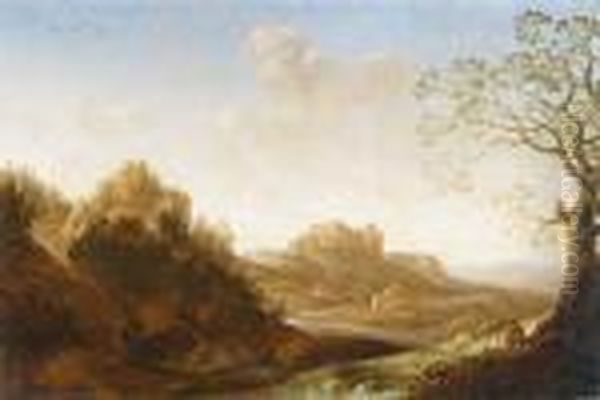
Saftleven masterfully captured atmospheric perspective, using subtle gradations of colour and tone to suggest depth and distance. His handling of light is often delicate, illuminating scenes with a clear, natural radiance. While many views were based on real locations observed during his travels, he often combined elements imaginatively, creating idealized or composite scenes rather than strict topographical records. This blend of observation and invention is a hallmark of his landscape art. He was also influenced by the Italianate landscape painters active in Utrecht, such as Cornelis van Poelenburch, incorporating elements of southern light and classical motifs into some works.
Iconic Landscapes and City Views
Saftleven's landscape oeuvre is diverse, encompassing various types of scenes. His river views, particularly those inspired by the Rhine, are perhaps his most famous contributions. Works like Imaginary Landscape River View (1670) exemplify his skill in creating vast, detailed panoramas filled with anecdotal detail – small figures, boats, animals – that invite close inspection. These paintings often convey a sense of tranquility and the harmonious coexistence of humanity and nature.
Beyond the grand river valleys, Saftleven also depicted the more intimate Dutch countryside around Utrecht, painting rural scenes with farmhouses and peasants. His interest extended to the urban environment as well. He produced a notable series of drawings and possibly paintings documenting views of Utrecht's city walls and fortifications, particularly along the southern side.
Furthermore, Saftleven created historically significant works documenting Utrecht's churches, notably before several were severely damaged by a tornado in 1674. These detailed depictions provide invaluable visual records of the city's architectural heritage. His skills in precise rendering also led him to undertake cartographic work; he was commissioned by the Utrecht city council to create maps of the city, demonstrating a practical application of his draughtsmanship and eye for detail that complemented his artistic pursuits.
A Keen Eye for Nature: Botanical Studies
Parallel to his landscape painting, Herman Saftleven developed a remarkable proficiency in botanical illustration. This aspect of his work is closely associated with his patronage from Agnes Block (1629-1704), a wealthy Mennonite merchant's wife and an enthusiastic horticulturalist and art collector. Block maintained a famous garden at her estate Vijverhof on the Vecht river, where she cultivated rare and exotic plants.
Between approximately 1670 and his death, Saftleven produced a series of highly detailed botanical studies for Agnes Block, primarily in watercolor and gouache on vellum. Around 27 such works are known. These were not mere decorative flower pieces but precise scientific records of specific plants, many of them newly introduced species from regions like South America and Africa grown in Block's garden.
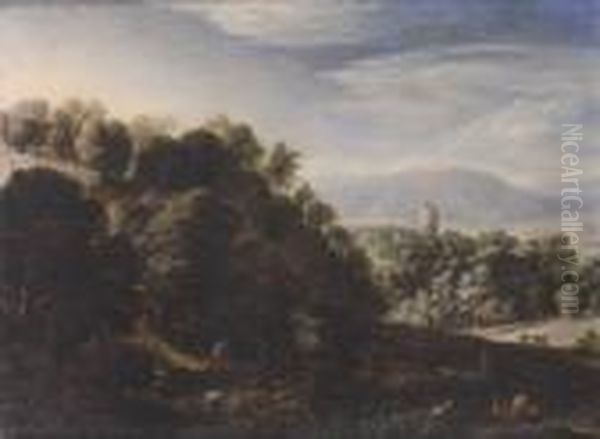
A prime example is his study Sticky Nightshade (Solanum sisymbriifolium), dated 1683. This work, like others in the series, showcases Saftleven's meticulous attention to detail, accurately rendering the plant's structure, texture, and colour. These botanical illustrations stand at the intersection of art and science, valued both for their aesthetic quality and their documentary importance in the history of botany and horticulture during a period of intense global exploration and discovery. They are considered among the finest examples of 17th-century Dutch botanical art.
Collaboration and Context: Saftleven and His Contemporaries
Herman Saftleven's career unfolded within the dynamic context of the Dutch Golden Age, interacting with numerous other artists through influence, collaboration, and competition. His most direct artistic connection was with his brother, Cornelis Saftleven. While their styles eventually diverged – Cornelis became known for peasant scenes, stable interiors, and sometimes satirical or allegorical works, often featuring animals – they did collaborate early in their careers. Notably, both brothers worked on decorations for the Honselaarsdijk Palace in the mid-1630s.
Saftleven absorbed influences from a range of landscape painters, including the aforementioned Jan van Goyen and Pieter de Molijn, as well as Abraham Bloemaert and Roelandt Savery, both prominent Utrecht masters whose work encompassed landscape elements. The influence of Jan Brueghel the Elder is evident in his detailed approach and panoramic compositions, while Cornelis van Poelenburch informed his occasional forays into Italianate landscapes.
The art market of the time was competitive. While Saftleven achieved considerable success, his work sometimes bore similarities to that of other artists, occasionally leading to confusion or misattribution. Works by artists like Pieter de Bloot or Frans Rijckhals have, at times, been mistaken for Saftleven's, highlighting the shared stylistic currents and competitive environment of the period. His marriage into the family of Hendrick van Vliet also placed him within a network of established Utrecht artists.
Teaching and Legacy: Shaping the Next Generation
As an established master and guild official in Utrecht, Herman Saftleven also took on pupils, contributing to the transmission of artistic knowledge and skill. Several artists are recorded as having studied with him, carrying forward aspects of his style or approach into their own careers.
Among his notable students were Abraham Hondius (c. 1625/1630–1691), who became known for his vigorous paintings of animals, particularly hunting scenes and animal fights, often influenced by Flemish artists like Frans Snyders and Paul de Vos. Hondius later moved to London, where he enjoyed a successful career.
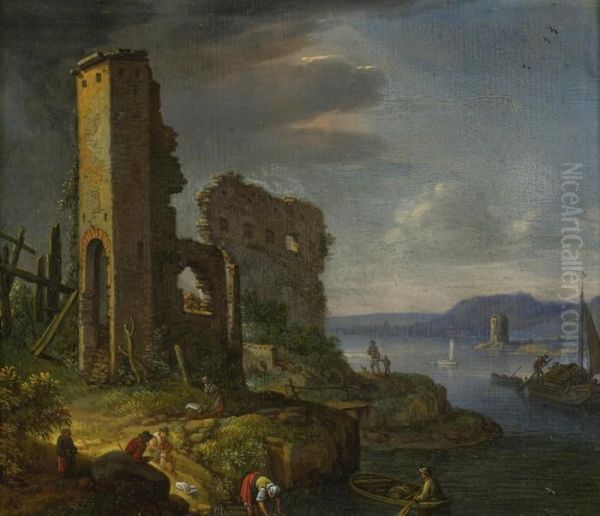
Ludolf de Jongh (1616–1679) was another pupil. De Jongh developed into a versatile painter known for portraits, genre scenes (including guardroom and stable interiors), and historical subjects. He sometimes collaborated with other artists, such as the architectural painter Anthonie de Lorme, painting figures into church interiors.
Egbert van der Poel (1621–1664) also studied under Saftleven. Van der Poel became particularly famous for his dramatic depictions of the Delft gunpowder magazine explosion of 1654, painting numerous views of the disaster and its aftermath. He was also skilled in painting nocturnal scenes, fires, and rustic landscapes, demonstrating versatility across different subjects and moods.
An anecdote, possibly apocryphal but illustrative of the focus on everyday life common in Dutch art, tells of one of Saftleven's students attempting to cross a muddy patch at a country wedding by stepping on pieces of bread to avoid dirtying his shoes, reflecting a humorous observation of human foibles. Through his teaching, Saftleven played a role in shaping the next generation of Dutch painters.
Artistic Techniques and Media
Herman Saftleven was proficient across several media. His oil paintings, particularly the landscapes, are characterized by fine brushwork, careful layering of glazes to achieve depth and luminosity, and a rich, often vibrant palette, especially in his mature works. He paid close attention to rendering textures, from the foliage of trees to the surfaces of rocks and water.
His drawings form a significant part of his output. Many were preparatory studies for paintings, but others were finished works in their own right. He often used black chalk and grey wash, sometimes heightened with white, to create atmospheric effects and detailed topographical records. His drawings of Utrecht and the Rhine valley showcase his skill as a draughtsman.
In the realm of botanical illustration, he primarily used watercolor and gouache on vellum, media well-suited for capturing the delicate details and colours of plants with scientific accuracy. Saftleven was also an accomplished printmaker, producing numerous etchings, mostly landscapes. His prints often replicate the panoramic scope and detailed observation found in his paintings and drawings, helping to disseminate his compositions more widely.
Historical Reputation and Influence
During his lifetime, Herman Saftleven enjoyed considerable recognition and success, evidenced by his long career, guild positions, and prestigious commissions like those from Agnes Block. However, like many artists of the Dutch Golden Age, his fame somewhat diminished in the centuries following his death as artistic tastes shifted.
The late 20th and early 21st centuries witnessed a renewed appreciation for the breadth and quality of 17th-century Dutch art, leading to a rediscovery and re-evaluation of Saftleven's work. Scholars and curators recognized the unique qualities of his landscapes – the blend of fantasy and reality, the meticulous detail, the panoramic scope – and the exceptional nature of his botanical studies.
Today, Herman Saftleven's works are held in major museum collections across the world, including the Rijksmuseum in Amsterdam, the Hermitage Museum in Saint Petersburg, the Louvre in Paris, the Kunsthistorisches Museum in Vienna, the Alte Pinakothek in Munich, and many others. His paintings, drawings, and prints are actively studied and exhibited.
His influence extended beyond his immediate pupils. His particular style of panoramic, detailed river landscape found resonance with later artists, particularly in Germany and Austria, where his compositions and treatment of light were sometimes emulated. His botanical work remains a benchmark for the integration of artistic skill and scientific observation in the 17th century.
Conclusion
Herman Saftleven the Younger was a remarkably skilled and multifaceted artist of the Dutch Golden Age. His extensive body of work, spanning detailed landscapes, precise botanical illustrations, drawings, and prints, showcases his keen powers of observation, technical mastery, and imaginative capacity. From the bustling riverbanks of the Rhine to the delicate structures of exotic plants, Saftleven captured the world around him with diligence and artistry. As a central figure in the Utrecht art scene for over half a century, a respected teacher, and an influence on subsequent generations, he holds a secure place in the history of Dutch art, celebrated for his unique contributions to landscape painting and botanical science through art.